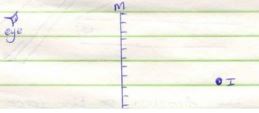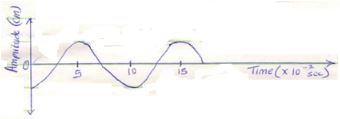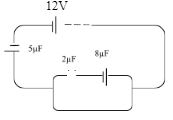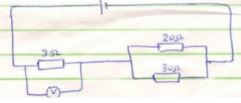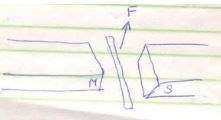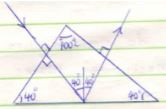PHYSICS
PAPER 2
TERM 2 OPENER EXAM
INSTRUCTIONS
- This paper consists of two sections; A and B
- Answer all the questions in section A and B
- All working must be clearly shown.
- Mathematical tables and electronic calculators may be used
- Candidates should answer the questions in English.
- Take g=10N/kg
SECTION A: 25 mks
- A Circuit consists of a battery, metal wire, ammeter and a switch connected in series. The switch is closed and the ammeter reading noted. The metal wire is now heated.
- State the observation made on the ammeter reading. (1mk)
- Give one reason for the above observation made. (1mk)
- 5 images are formed when two mirrors are inclined at an angle between them. Determine the angle of inclination. (2mks)
- A current carrying conductor AB is a magnetic field as shown in the figure below.

- Indicate the direction of the force F acting on the conductor. (1mk)
- State two factors that determine the direction of the force F. (2mks)
- The figure 1 below shows the image behind a mirror M
By ray diagram construction, locate the position of the object. (2mks) - A negatively charged rod is brought near the cap of a leaf electroscope. The cap is then earthed momentarily by touching with a finger. Finally the rod is withdrawn. State and explain the observation mode. (2mks)
- A student stands at a distance 400m from a wall and claps two pieces of wood. After the first clap, the student claps whenever an echo is heard from the wall. Another student starts a stopwatch at the first clap and stops it after the twentieth clap. The stopwatch records a time of 50 seconds. Find the speed of sound. (2mks)
- In the fig. 4 shown below (not drawn on scale) sketch the path of a ray till it emerges from the prism. (1mk)
- Describe the changes that can be observed during discharging process of lead-acid accumulator. (2mks)
- The figure below shows a current carrying conductor placed perpendicularly between the poles of a magnet.
- Show on the diagram the magnetic field pattern. (1mk)
- The direction of the net force on the conductor. (1mk)
- Using domain theory, describe how a nail can be magnetized through hammering. (2mks)
-
- Define focal plane. (1mk)
- State two properties of images formed by convex mirrors. (2mks)
SECTION B (55 MARKS)
- Some plain water waves were produced in a ripple tank. They pass from a region of deep water into a region of shallow water. The figure shows what the waves look like from above
- State what happens at the boundary to:
- The frequency of the waves (1 mark)
- The speed of the waves (1 mark)
- The wave length of the waves (1 mark)
- The waves have a speed of 0.12m/s [in the deep water. Wave crests are 0.08m apart to the deep water. Calculate the frequency of the sources producing the waves. (3 marks)
- State two differences between a stationary wave and a progressive wave. (2 marks
- The wave shown in the figure below has a velocity of 200ms-1
Determine:- The period T of the wave. (2mks)
- The frequency of the wave. (2mks
- The wavelength of the wave. (2mks
- State two difference between electromagnetic waves and mechanical waves. (2 marks)
- State what happens at the boundary to:
-
- State one application of a capacitor. (1 mrk)
- The figure shows four capacitors connected to a battery of 12volts
Calculate- Effective capacitance (3mks)
- Charge on 3.2µF (3 marks
- P.d across 5 µF (2 marks)
- The energy stored by 2 µF (2 marks)
- State any two factors that affect capacitance of a conductor. (2 marks)
- Why is repulsion the surest way for polarity of a magnet. (1 mark)
-
- State Ohm’s law. (1mk)
- Three resistors 1Ω, 3Ω and 5Ω are connected together in a circuit. Draw a circuit diagram to show an arrangement that would give minimum resistance and determine that resistance. (3mks)
- The cell in a figure below has an e.m.f. of 1.8V abd negligible internal resistance.
Determine:- Total resistance in a circuit. (3mks)
- The current in the circuit. (3mks)
- Reading of the voltmeter. (3mks)
-
- State Snell’s law. (1mk)
- A coin is placed beneath a transparent block of thickness 10cm and refractive index 1.56. Calculate the vertical displacement of the coin. (3mks)
- The speed of green light in a prism is 1.94 x 108ms-1
- Determine the refractive index of the prism material. (Speed of light in air = 3.0 x 108ms-1). (3mks)
- Determine the critical angle of the prism material. (3mks)
- State two advantages of using optical fibres in communication. (2mks)
MARKING SCHEME
-
- The ammeter reading decreases.
- The resistance of the metal increases with increase in temperature.
- 5 + 1 = 360/θ
θ = 360/6 = 60º
-
-
-
- Direction of magnetic field.
- Direction of current in the conductor.
-
-
- On earthing negative charges are repelled to the ground. When the rod is withdrawn, the leaf is left with a net positive charge. The leaf rises.
- Speed = 2d/t
t = 500/20 = 2.5 s
Speed = 2 x 400/2.5 = 320ms-1 -
- Hydrogen gas bubbles at the cathode.
- White deposit forms at the plates.
- Relative density of the electrolyte drops.
-
-
- From N - S ; around conductor
-
-
- Nail is hammered in North – South direction.
- Earth’s magnetic field aligns dipoles of the nail in one direction.
-
- Focal plane is a plane passing through the focal point and perpendicular to the principal axis.
- Produces as
- Upright image
- Magnified image
- Virtual
SECTION B
-
-
- Frequency not affected
- Speed reduces
- Wavelength reduces
- f=v/ƛ=0.02/0.08=1.5Hz
-
Stationary wave Progressive wave No energy is transferred from source energy is transferred from source Wave form does not appear to move wave form moves away continuously -
- Time taken to make one complete oscillation
10 x 10-2 seconds - F = I/T
I
10 x 10-2 = 10Hz - V = λf
X = v/f
= 200/10 = 20m
- Time taken to make one complete oscillation
- Mechanical waves require material medium for transmission but electromagnetic waves do not
-
-
-
- Rectification smoothing circuits
- Turning circuits
- Camera flash
(any one correct)
-
-
- 2×8/2+8=16/10=1.6µF
1.6+3.2=4.8µF
CT=5×4.8/5+4.8=24/9.8=2.45×10-6F
- 2×8/2+8=16/10=1.6µF
-
- Q=CV
2.45×10-6×12=2.94×10-5C
Charge on 3.2µF=2/3×2.94×10-5
=1.96 X 10-5
- Q=CV
-
- P.d on 5µF =Q/C=2.94×10-5=5.88V
5×10-6
- P.d on 5µF =Q/C=2.94×10-5=5.88V
-
- Energy = ½ CV2
= ½ ×2×10-6×6.122
=3.75 X 10-5 - Area (cross sectional area)
- length of a conductor
- Energy = ½ CV2
-
-
-
- A current flowing through a conductor is directly proportional to the potential difference across it provided the temperature and other physical conditions are kept constant.
1 - 1 + 1 + 1 = 5 + 15 + 3 = 23
RT 3 1 5 15 15
RT = 15/23 = 0.6522 Ω-
- 3 + 20 x 30 = 3 + 60 = 4.2Ω
20 + 20 50 - I = V = 1.8 = 0.428 A
R 4.2 - V = 1R = 0.428 x 3 = 1.2857 V
- 3 + 20 x 30 = 3 + 60 = 4.2Ω
-
- The ratio of the sine of angle of incidence to the sine of the angle of refraction is constant.
- P = Real depth
Apparent depth
1.56 = 10/X
1.56 x = 10
X = 10/1.56 = 6.410
Vertical displacement = 10 - 6.410 = 3.59cm -
- n = Velocity of light in vacuum
Velocity of light in medium
n = 3.0 x 108
1.94 x 108
= 1.546 - I = 1.546
Sin C
Sin C = 1/1.546
C = 40.30º
- n = Velocity of light in vacuum
-
- Minimal energy loses due to total internal reflection.
- Large quantity of data can be converted per second or unit time.
- Its flexible.
Download Physics Paper 2 Questions And Answers - Form 3 Term 2 Opener Exams 2021.
Tap Here to Download for 50/-
Get on WhatsApp for 50/-
Why download?
- ✔ To read offline at any time.
- ✔ To Print at your convenience
- ✔ Share Easily with Friends / Students

